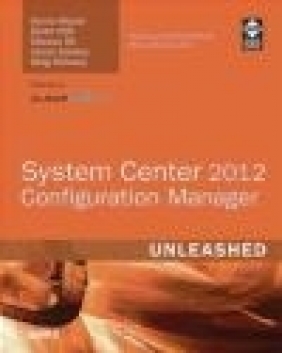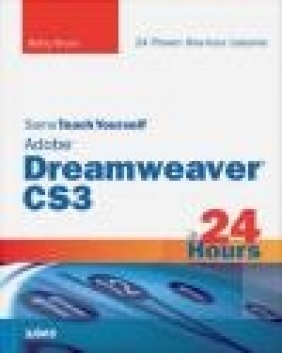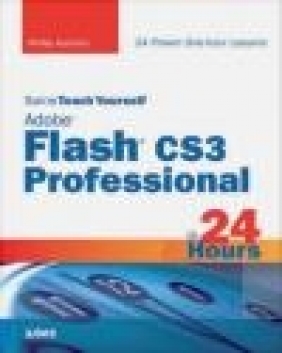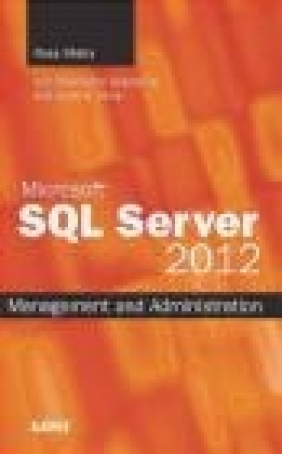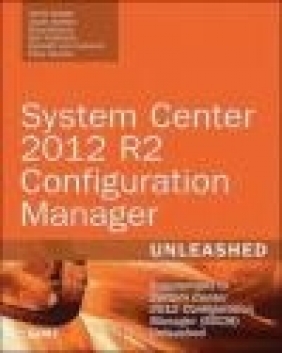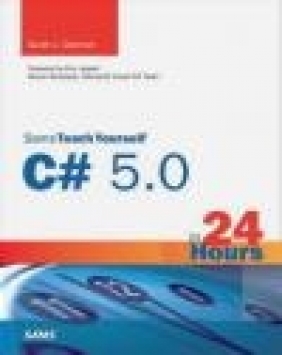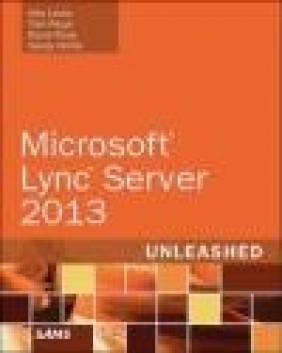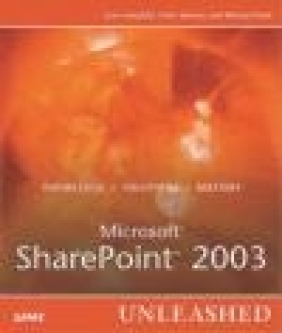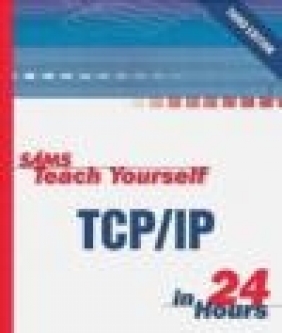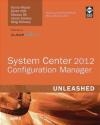System Center 2012 Configuration Manager (SCCM) Unleashed
Greg Ramsey, Jason Sandys, Marcus Oh
System Center 2012 Configuration Manager (SCCM) Unleashed
Greg Ramsey, Jason Sandys, Marcus Oh
- Producent: Sams Publishing
- Rok produkcji: 2012
- ISBN: 9780672334375
- Ilość stron: 1360
- Oprawa: Miękka
Niedostępna
Opis: System Center 2012 Configuration Manager (SCCM) Unleashed - Greg Ramsey, Jason Sandys, Marcus Oh
This is the comprehensive reference and technical guide to Microsoft System Center Configuration Manager 2012. A team of expert authors offers step-by-step coverage of related topics in every feature area, organized to help IT professionals rapidly optimize Configuration Manager 2012 for their requirements, and then deploy and use it successfully. The authors begin by introducing Configuration Manager 2012 and its goals, and explaining how it fits into the broader System Center product suite. Next, they fully address planning, design, and implementation. Finally, they systematically cover each of Configuration Manager 2012's most important feature sets, addressing issues ranging from configuration management to software distribution. Readers will learn how to use Configuration Manager 2012's user-centric capabilities to provide anytime/anywhere services and software, and to strengthen both control and compliance. The first book on Configuration Manager 2012, System Center Configuration Manager 2012 Unleashed joins Sams' market-leading series of books on Microsoft's System Center product suite: books that have achieved go-to status amongst IT implementers and administrators worldwide.Foreword by Wally Mead xxix Introduction 1 PART I: Configuration Manager Overview and Concepts Chapter 1 Configuration Management Basics 7 Ten Reasons to Use Configuration Manager 8 The Evolution of Systems Management 9 Hurdles in the Distributed Enterprise 10 The IT Automation Challenge 10 Configuration "Shift and Drift" 11 Lack of Security and Control 11 Timeliness of Asset Data 12 Lack of Automation and Enforcement 12 Proliferation of Virtualization and Cloud Computing 12 Lack of Process Consistency 13 The Bottom Line 13 Systems Management Defined 14 Microsoft's Strategy for Service Management 15 Microsoft's Dynamic Systems Initiative 16 IT Infrastructure Library and Microsoft Operations Framework 19 Total Quality Management: TQM 24 Six Sigma 24 Service Management Mastery: ISO 20000 24 Optimizing Your Infrastructure 25 Overview of Microsoft System Center 29 Reporting in System Center 30 Operations Management 31 Service Management 31 Protecting Data 32 Virtual Machine Management 32 Deploy and Manage in the Cloud 33 Orchestration and Automation 33 Cloud-Based Configuration Monitoring 34 Endpoint Protection 34 The Value Proposition of Configuration Manager 34 Summary 35 Chapter 2 Configuration Manager Overview 37 The History of Configuration Manager 37 Systems Management Server 1.x 38 Systems Management Server 2.0 38 Systems Management Server 2003 39 System Center Configuration Manager 2007 41 System Center 2012 Configuration Manager 42 Terminology in Configuration Manager 42 Site Hierarchy 43 Site 44 Site Systems 46 Senders 48 Addresses 49 Configuration Manager Discovery Types 49 Configuration Manager Agent 50 Configuration Manager Console 51 Collections 52 Queries 52 Alerts 53 Status System 53 Managing Applications 54 Content Management 57 Software Update Management 59 Compliance Settings 59 BITS 59 Software Metering 60 Network Access Protection 60 BranchCache 61 Reporting 61 What's New in This Version 62 64-Bit Site System Requirements 62 User-Centric Management 62 Applications and Packages 63 Hierarchy Changes 63 New Configuration Manager Console 64 Enhancements to BITS 64 Application Catalog 64 Extended Mobile Device Management 65 Management Point Enhancements 65 Boundary Changes 65 Fallback Site 66 Centrally Managed Client Settings 66 Role-Based Administration 66 Backup and Recovery 66 Collection Changes 67 Client Health Status Enhancements 68 Compliance Settings Changes 68 Remote Control Improvements 69 Hardware Inventory Improvements 69 Power Management Improvements 70 Software Updates Improvements 72 Improved End User Experience 73 Content Library 73 Operating System Deployment 73 Distribution Point Changes 74 System Center 2012 Endpoint Protection Integration 75 Feature Dependencies of System Center 2012 Configuration Manager 75 Summary 77 Chapter 3 Looking Inside Configuration Manager 79 Design Concepts 80 Active Directory Integration 81 Schema Extensions 81 Additional Active Directory Benefits 90 A WMI Primer 91 WMI Feature Set and Architecture 91 Inside the WMI Object Model 95 Managing WMI 98 Looking Inside the CIMV2 Namespace 103 WMI in ConfigMgr 111 ConfigMgr Client Namespaces 111 Hardware Inventory Through WMI 112 Additional Client Operations Through WMI 116 WMI on ConfigMgr Servers 120 Components and Communications 124 Inside the ConfigMgr Database 133 ConfigMgr Tables and Views 133 Using SQL Server Management Studio 134 Viewing Detailed Process Activity 138 SQL Replication Crash Course 146 Configuration Manager Database Replication 148 File-Based Replication 154 Summary 157 PART II: Planning, Design, and Installation Chapter 4 Architecture Design Planning 161 Developing the Solution Architecture 161 Establishing Business Requirements 162 Assessing Your Environment 163 Planning for Licensing 165 Hierarchy Planning 167 Configuration Manager Sites 167 Planning Your Hierarchy Structure 169 Planning Boundaries and Boundary Groups 170 Choosing Client Discovery and Installation Methods 172 Defining Your Client Architecture 174 Planning for User-Centric Management 178 Planning Content Management 178 Planning for Infrastructure Dependencies 180 Active Directory Considerations 180 Planning Certificate Services 183 Site Planning 186 Site Servers and Site Systems Planning 186 Capacity Planning 188 Developing the Server Architecture 189 Planning for Solution Scenarios 190 Software Update Planning 190 Planning for Internet-Based Clients 193 Out of Band Management Planning 195 Testing and Stabilizing Your Design 197 The Proof of Concept 198 The Pilot Deployment 204 Summary 204 Chapter 5 Network Design 205 Understanding Your Network 206 Configuration Manager Data Flow . 206 Intrasite Server Communications 208 Communications with SQL Server 208 Communications Using RPC 209 Communications Using SMB 209 Replication of Deployment Content Refresh Data 213 Site System Communications Using HTTP and HTTPS 214 Other Server Communications 214 Client to Server Communications 214 Client Ports and Protocols 215 Reasons for Changing Ports 215 Initial Communication 221 Identifying and Contacting the Client's Assigned Site 222 Client Protocols 222 Planning for Network Access Protection 224 Site-to-Site Communications 225 Database Replication 225 File-Based Replication 226 Data Priorities 227 Fast Network and Slow Network Boundaries 227 Use of BITS 229 BITS Versions for ConfigMgr Clients 230 Modifying BITS Functionality Through Group Policy 231 Modifying BITS Functionality Within ConfigMgr 232 Comparative Advantages of Group Policy and ConfigMgr Settings for BITS 233 Systems with Multiple Interfaces and File Integrity Checking 233 ConfigMgr and BranchCache 234 Server and Site Placement 236 Deploying Servers to Support Internet-Based Clients 237 Using a Dedicated Site for Internet Clients 238 Allowing Site-to-Site Communications Across an Inner Firewall 239 Having a Site Span the Internal Network and Perimeter Network 240 Using Web Proxies and Proxy Enrollment Points 240 Intermittently Connected Users 241 Network Discovery 241 Discovering Network Topology 243 Topology and Client Discovery 245 Discovering Topology, Client, and Client Operating Systems 245 Troubleshooting ConfigMgr Network Issues 246 Network Configuration Issues 247 Basic Connectivity Problems 247 Name Resolution Issues 248 Blocked or Unresponsive Ports 249 Timeout Issues 250 Identifying Network Issues Affecting ConfigMgr 250 Summary 259 Chapter 6 Installing System Center 2012 Configuration Manager 261 Configuring Pre-Installation Requirements 261 Windows Components 262 Supported SQL Server Requirements 263 Validating and Configuring Active Directory Requirements 265 Windows Server Update Services 265 Prerequisite Checker 265 Using the Prerequisite Files Downloader 269 Performing Site Installations 270 Installing the Central Administration Site 271 Installing Primary Sites 278 Installing Secondary Sites 288 Installation Validation 294 Site Properties 296 Initial Configuration 296 Installing Optional Site Systems 301 Uninstalling Sites 309 Uninstalling Primary Sites 309 Uninstalling Secondary Sites 312 Uninstalling a Full Hierarchy 314 Troubleshooting Site Installation 315 Summary 316 Chapter 7 Migrating to System Center 2012 Configuration Manager 317 About Migration 318 Migration Background and Introduction 318 Migration, Not an Upgrade 319 Planning the Migration 320 Central Site and Hierarchy Concepts in 2012 320 About Site Mode 321 What Is Migrated 321 What Is Not Migrated 323 Pre-Migration Activities 324 Coexistence Considerations 327 Migrating Your Configuration Manager Infrastructure 327 Site Servers and Site Roles 328 Security Considerations 332 Boundaries and What's Changing 337 Performing the Migration 338 Migrating Features and Objects 338 Migrating by Feature and Dependencies 338 Migration Dependencies Configuration 339 Configuring the Active Source Site 343 Configuring Child Sites for Data Gathering 345 Migration Jobs 347 Shared Distribution Points 366 Migration Clean Up 367 Migrating Reports 369 Legacy Reports 369 SSRS Reports 369 Custom Reports 369 Client Migration and Methods 370 Background and Client Migration Concepts 370 Client Migration Strategies for Your Network 371 Troubleshooting Migration Issues 371 Summary 372 PART III: Configuration Manager Operations Chapter 8 The Configuration Manager Console 375 Console Highlights 376 Touring the Console 376 Configuration Manager Console Panes 377 Configuration Manager Console Bars 378 Backstage 378 ConfigMgr Workspaces 379 Assets and Compliance Workspace 380 Software Library Workspace 380 Monitoring Workspace 381 Administration Workspace 383 Console Node Details 384 Console Deployment 388 Console Placement 389 Supported Platforms 389 ConfigMgr Console Prerequisites 390 Installation Using the ConfigMgr Setup Wizard 391 Unattended Console Installation 394 Role-Based Administration 395 Introducing the "Show Me" Behavior 395 Behind the Scenes 397 The Three States of Interaction 397 Connecting to a Site 398 Recent Connections 398 Clearing Recent Connections 398 Personalizing the Console 400 The In-Console Alert Experience 401 Viewing Alerts 401 Managing Alerts 402 Configuring Alerts 403 Subscribing to Alerts 404 Configuration Manager Service Manager 404 Initiating the Configuration Manager Service Manager Console 406 Operating the Configuration Manager Service Manager Console 407 Security Considerations 408 SMS Provider Permissions 409 DCOM Permissions 409 WMI Permissions 409 Troubleshooting Console Issues 411 Console Logging 411 Verify Security 412 Connectivity Issues 416 Common Problems with the ConfigMgr Console 416 Summary 417 Chapter 9 Configuration Manager Client Management 419 Discovery 419 Active Directory Forest Discovery 420 Active Directory Group Discovery 422 Active Directory User Discovery 424 Active Directory System Discovery 426 Heartbeat Discovery 427 Network Discovery 429 Manually Importing Clients into ConfigMgr 431 ConfigMgr Client Requirements 432 Hardware Dependencies 432 Software Dependencies 433 Supported Platforms 433 ConfigMgr Client Installation 435 Manual Installation 435 Installing with Logon Scripts 441 Client Push 442 Group Policy 447 Software Update Point 448 Client Approval 449 Blocking and Unblocking Clients 450 Automatically Upgrading the Client 450 Troubleshooting Client Installation 451 Client Assignment 453 Client Health 454 Client Settings 459 Defining Priority 461 Background Intelligent Transfer Device Settings 461 Client Policy Device Settings 463 Compliance Settings Device Settings 463 Computer Agent Device Settings 464 Computer Restart Device Settings 466 Endpoint Protection Device Settings 466 Hardware Inventory Device Settings 467 Network Access Protection (NAP) Device Settings 470 Power Management Device Settings 471 Remote Control Device Settings 471 Software Deployment Device Settings 476 Software Inventory Device Settings 477 Software Metering Device Settings 479 Software Updates Device Settings 481 State Messaging Device Settings 482 User and Device Affinity Settings 482 Using the Resource Explorer 483 Wake On LAN 484 WOL Prerequisites 484 Two Types of WOL 485 Configuring WOL 486 Using WOL 487 Summary 488 PART IV: Software and Configuration Management Chapter 10 Managing Compliance 491 New and Improved in System Center 2012 Configuration Manager 493 Configuring Compliance Settings 493 Configuration Items and Baselines 495 Configuration Items 496 Configuration Baselines 512 Compliance Evaluation 517 Versioning 519 Configuration Packs 521 Exporting Configuration Items and Baselines 522 Compliance Authoring 523 Compliance Strategy 525 Reporting 526 On-Demand Results 527 Alerting 527 Remediation 528 Troubleshooting 529 Summary 531 Chapter 11 Packages and Programs 533 About Packages, Programs, Collections, Distribution Points, and Deployments 534 Packages 534 Programs 534 Collections 535 Distribution Points 535 Deployments 536 Combining the Use of Packages, Programs, Collections, and Deployments 536 Creating a Package 536 Creating a Package from the Package Definition Wizard 537 Package Properties 543 Creating a Package with the New Package Wizard 559 Custom Packages 562 Repackaging Software 562 Avoiding Common ConfigMgr Software Packaging Issues 563 Program and Package Properties 563 Testing, Testing, Testing 563 Summary 564 Chapter 12 Creating and Managing Applications 565 ConfigMgr Applications Overview 566 About Applications 566 About Deployment Types 567 About Detection Methods 569 About User Device Affinity 569 About Creating Applications 571 Creating a Windows Installer (MSI)-Based Application 571 Application Properties 576 Creating Deployment Types 591 Creating a Windows Installer-Based Deployment Type 592 Creating an Application Virtualization Deployment Type 595 Creating a Script-Based Deployment Type 599 Creating Detection Methods 602 Detection Methods for Windows Installer Applications 602 Other Detection Methods 604 Custom Script Detection Methods 607 Managing and Creating Global Conditions 610 Device Global Conditions 611 User Global Conditions 612 Custom Global Conditions 612 More About Managing Applications 617 Adding Dependencies 617 Managing Revision History 619 Exporting and Importing Applications 620 Superseding Applications 621 Retiring and Deleting Applications 622 Package Conversion Manager 623 Summary 626 Chapter 13 Distributing and Deploying Applications 627 Creating and Managing Collections 628 Direct Rule 630 Query Rule 631 Include Rule 634 Exclude Rule 634 About Incremental Updates 634 User Collections Versus Device Collections 635 About Distribution Points 635 Installing Distribution Points 637 Distribution Point Groups 640 Associating Collections with Distribution Point Groups 641 Sending Content to Distribution Points 642 Monitoring Distribution Point Status 642 Updating Content on Distribution Points 645 Refreshing Content on Distribution Points 646 Removing Content from Distribution Points 646 Validating Content 647 Using BranchCache 647 Preferred Distribution Points 648 Prestaging Content 648 Importing and Exporting Content 652 Troubleshooting Content Distribution 654 About the Content Library 654 Deploying Packages and Applications 654 End User Experience 660 Software Center 660 Application Catalog 662 Monitoring and Troubleshooting Deployments 665 Simulated Deployments 667 Summary 667 Chapter 14 Software Update Management 669 What's New in 2012 670 Planning Your Update Strategy 670 Incorporated Tools 672 The Windows Update Agent 673 Windows Software Update Services 673 Preparing for Software Updates with ConfigMgr 674 Prerequisites for Software Updates 674 Software Update Points 676 Client Settings 687 Group Policy Settings 689 Software Update Building Blocks 692 All Software Updates 692 Software Update Groups 696 Update Deployments 698 Update Templates 703 Deployment Packages 704 Automatic Deployment Rules 706 Maintenance Windows 708 Superseded Updates 711 The Software Updates Process in Action 711 Software Update Decisions, Design, and Workflow 714 Compliance Scanning 716 End User Experience and Interaction 717 Notifications 717 Updates and Software Center 718 Update Installation 720 System Restarts and Restart Notifications 721 Monitoring Software Updates 723 Individual Update Status 723 Update Deployment Status 723 Reporting 724 A Super-Quick Walkthrough 724 Troubleshooting Software Updates 725 WSUS and SUP 725 Downloading Updates 726 Client Update Scanning and Deployment 727 Beyond the Built-In Update Process 727 System Center Update Publisher 728 SCUP Installation 728 SCUP Configuration 729 Catalogs 733 Publications 735 Updates 735 Custom Updates 737 Rules 741 Quick Walkthrough 742 Using NAP to Protect Your Network 742 NAP Prerequisites 742 Agent Settings 744 System Health 744 Client Compliance 747 Remediation 748 Summary 748 Chapter 15 Mobile Device Management 751 Planning for Mobile Device Management 752 Overview of Mobile Device Management 753 Light Management 753 Exchange Server Connector 754 Access Rules 762 Troubleshooting Light Management 764 Working with Devices 764 End User Experience 767 In-Depth Management 768 Public Key Infrastructure 771 Heartbeat Discovery 771 Mobile Device Management Site Roles 772 Client Settings 775 Enrolling Mobile Devices 779 Software Deployment 780 Compliance Settings 782 Reporting 782 Partner Extensibility 783 Summary 784 Chapter 16 Endpoint Protection 785 Prerequisites for Endpoint Protection 787 Planning and Considerations 788 Creating Custom Client Settings and Antimalware Policies 788 Deciding from Where to Update and When 789 Deploying to a Test Collection First 789 Categorizing Client Remediation Status 790 Targeting Collections with Custom Antimalware Policy and Client Settings 790 Installing the Endpoint Protection Role 792 Configuring the SUP for Endpoint Protection 797 Configuring the SUP to Synchronize Definition Updates 797 Creating Auto Deployment Rules for Definition Updates 799 Working with Antimalware Policies 804 Understanding the Default Antimalware Policy 804 Creating Custom Antimalware Policy 807 Importing and Merging Antimalware Policies 808 Configuring Alerts for Endpoint Protection 809 Configuring Email Notification 810 Configuring Alerts for Device Collections 812 Configuring Alert Subscriptions 813 Configuring Custom Client Device Settings for Endpoint Protection 814 Deploying Endpoint Protection Custom Client Agent Settings 815 Monitoring Status in Endpoint Protection 816 Configuring Collections to Appear in Collection View 816 Security State View for the Selected Collection 816 Operational State View for Clients and Computers in the Selected Collection 818 Performing On-Demand Actions for Malware 819 Reporting in Endpoint Protection 820 Creating and Deploying Windows Firewall Policies 823 Understanding the Endpoint Protection Client 824 Installing the Endpoint Protection Client 827 Understanding Endpoint Protection Client Settings 827 Communication Between the Client and the Server 829 Automatic Removal of Antimalware Software 829 Removing the Endpoint Protection Client 830 Delivery of Definition Updates 830 Summary 831 Chapter 17 Configuration Manager Queries 833 Introducing the Queries Node 834 Organizing the Query List Pane 835 Viewing Queries and Query Results 837 Creating Queries 838 WMI Query Language 838 Objects, Classes, and Attributes 839 ConfigMgr Query Builder 841 Criterion Types, Operators, and Values 846 Criterion Types 846 Operators 848 Values 850 Writing Advanced Queries 851 Limitations of Extended WQL in ConfigMgr 852 Utilizing the Date and Time Functions in WQL Queries 853 Examples of Advanced Queries 854 Converting WQL to SQL 857 Relationships, Operations, and Joins 858 Querying Discovery Data 860 Querying Inventory Data 861 Using Query Results 863 Exporting Query Results to a Text File 863 Importing and Exporting Queries Between Sites 863 Creating a Collection Based on Query Results 866 Status Message Queries 866 Viewing Status Messages 867 Creating Status Message Queries 868 Summary 870 Chapter 18 Reporting 871 SQL Server Reporting Services Overview 871 Implementing SSRS 872 SQL Server Version Selection 872 Server Placement Options 872 SSRS Installation 873 SSRS Configuration 876 Backing Up SSRS 882 Reporting Best Practices 884 Interacting with Reports from the Console 885 Search Capability 885 Running Reports 886 Creating Subscriptions 887 Managing SSRS Report Security 890 Creating a Report 890 Authoring Custom Reports 893 Development Tool Selection 893 Building a Custom Report 893 Interactive Features 902 Advanced Reporting Techniques 903 Advanced Custom Report Example 904 Authoring Best Practices 912 Built-in ConfigMgr Reports 912 Troubleshooting SSRS 945 SSRS Logs 945 Report Server Event Errors 946 Optimizing SSRS Performance 949 Subscriptions 950 Report Caching 950 Report Snapshots 950 Report Timeout Values 950 Performance Best Practices 951 Reporting on Reporting Services 951 System Center Data Warehouse 957 Summary 958 Chapter 19 Operating System Deployment 959 What OSD Does 960 What's New in OSD 961 Deployment Scenarios 963 Tools Incorporated into OSD 965 Sysprep 965 Windows Auto mated Installation Kit 966 User State Migration Tool 968 OSD Phases 968 Planning 969 Preparation 969 Creation 970 Testing 970 Productionization 970 OSD Building Blocks 970 Drivers 971 Driver Packages 975 Operating System Images 976 Operating System Installers 976 Boot Images 977 Task Sequences 984 Site System Roles 1020 Distribution Points 1020 State Migration Point 1025 Driver Management 1030 Drivers in the Image 1031 Drivers After the Image 1031 User State 1032 USMT 1034 Computer Associations 1036 User State Without SMP 1038 Image Operations 1039 Image Creation 1039 Image Upkeep 1044 Offline Software Updates 1045 Image Deployment 1047 User Device Affinity 1049 Deployment Challenges 1050 Application Compatibility 1051 User Data 1052 Image Maintenance 1052 Hardware Considerations 1054 Monitoring Task Sequence Deployments 1057 Update Deployment Status 1057 Reporting 1058 Troubleshooting 1058 Command Line Support 1058 The Smsts.log File 1060 Windows Setup Log Files 1061 Troubleshooting USMT 1061 Summary 1061 PART V: Administering System Center Configuration Manager Chapter 20 Security and Delegation in Configuration Manager 1065 Planning for Security and Delegation 1065 ConfigMgr Security Solutions 1067 Role-Based Administration 1068 Managing Administrative Users 1069 Security Roles 1070 Security Scopes 1074 Associating Security Scopes and Collections with Individual Roles 1077 Administrative Security Reports 1078 RBA Under the Hood 1079 Preventing Unauthorized Access to ConfigMgr 1084 Securing Access at the Active Directory Level 1084 Securing Access at the Database Level 1085 Auditing ConfigMgr Administrative Actions 1086 Securing the ConfigMgr Infrastructure 1089 Building Security into Your Hierarchy 1089 Securing Site Systems 1090 ConfigMgr Cryptographic Controls 1096 ConfigMgr Network Security 1097 ConfigMgr Content Security 1115 Securing ConfigMgr Accounts 1116 Summary 1123 Chapter 21 Backup, Recovery, and Maintenance 1125 Performing Site and SQL Server Backups 1125 Backing Up ConfigMgr 1126 Restoring ConfigMgr Backups 1129 Site Maintenance Options 1136 Using Backup and Restore to Migrate to New 1139 SQL Replication 1140 Monitoring SQL Replication 1140 Replication Link Analyzer 1143 Alerts for SQL Replication 1144 Site Maintenance 1145 Site Maintenance Tasks 1145 DDR Retention 1155 Obsolete Records 1162 How a Record Can Be Marked Obsolete 1163 Database Maintenance 1165 Making the Status Message System Work for You 1166 Maintaining Status Data 1167 Status Filter Rules 1169 Status Summarizers 1172 Monitoring Configuration Manager with Operations Manager 1174 Services and Descriptions 1175 Summary 1176 PART VI: Appendixes Appendix A Configuration Manager Log Files 1179 Related Documentation 1180 Viewing Log Files 1180 Enabling Logging 1181 Client Logs 1183 Server Logs 1188 Functionality Logs 1194 Software and Application Installation Logs 1207 Log File Mining 1209 Appendix B Extending Hardware Inventory 1211 How to Extend Hardware Inventory 1212 Example of Extending Inventory 1213 Creating a Device Collection 1223 Appendix C Reference URLs 1225 General Resources 1225 Microsoft's Configuration Manager Resources 1229 Other Configuration Manager Resources 1234 Blogs 1235 Microsoft System Center 1237 Public Forums 1237 Utilities 1238 Appendix D Available Online 1241 SQL Profiler Template 1241 Top 10 Most Executed Reports Query 1241 OSD Starter Scripts 1241 Live Links 1242 Index 1243
Szczegóły: System Center 2012 Configuration Manager (SCCM) Unleashed - Greg Ramsey, Jason Sandys, Marcus Oh
Tytuł: System Center 2012 Configuration Manager (SCCM) Unleashed
Autor: Greg Ramsey, Jason Sandys, Marcus Oh
Producent: Sams Publishing
ISBN: 9780672334375
Rok produkcji: 2012
Ilość stron: 1360
Oprawa: Miękka
Waga: 1.64 kg



















